The Wadden Sea is the souteastern part of the North Sea. The Wadden Sea stretches from the city of Den Helder in the Netherlands in the southwest to its northern bounderies north of the city of Esbjerg in Denmark, crossing the estuaries of the rivers in the northwest of Germany. The Wadden Sea is the largest unbroken system of intertidal sands and mudflats in the world. The salt marshes of the Wadden Sea are covered with salt tolerant plants. About 2300 species of flora and fauna can be found in the salt marshes of the Wadden Sea. Animals like seals live in the Wadden Sea and give birth to their pups on the sandflats. The Wadden Sea is a popular breeding area and tanking station for migrating birds. The Westerheversand Lighthouse is the most famous landmark on the Eiderstedt peninsula in the German state Schleswig-Holstein, thousands of migrating birds pass the lighthouse each year. The Wadden Sea UNESCO World Heritage comprises the Wadden Sea Conservation Area in the Netherlands, the Wadden Sea National Parks of Lower Saxony and Schleswig-Holstein in Germany and most of the Wadden Sea in Denmark. The Dutch and the German parts of the Wadden Sea gained the status as a UNESCO World Heritage in 2009. The Wadden Sea Nationalpark Vadehavet in Denmark was added to the World Heritage Site in 2014. The Wadden Sea is a natural World Heritage Site.
www.werelderfgoedfotos.nl © Copyright World Heritage Photos

Wadden Sea: The Westerheversand Lighthouse is one of the famous lighthouses in the north of Germany. The lighthouse is made of cast iron and is about 40 metres tall. The Westerheversand Lighthouse is situated in the salt marshes of the Schleswig-Holstein Wadden Sea National Park, the largest national park of Germany. In 2009, the Dutch and German parts of the Wadden Sea were declared a UNESCO World Heritage.
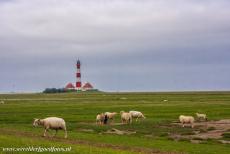
Wadden Sea: The Westerheversand Lighthouse is one of the famous lighthouses in the north of Germany. The lighthouse is made of cast iron and is about 40 metres tall. The Westerheversand Lighthouse is situated in the salt marshes of the Schleswig-Holstein Wadden Sea National Park, the largest national park of Germany. In 2009, the Dutch and German parts of the Wadden Sea were declared a UNESCO World Heritage.
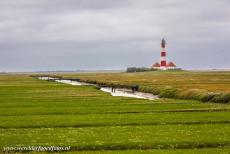
The German part of the Wadden Sea: The Westerheversand Lighthouse was built on a dwelling mound in 1907. The builings of the lighthouse accommodate the Wadden Sea laboratory and an exhibition including fish tanks, shells, driftwood and many other treasures from the driftline of the Wadden Sea. The Westerheversand Lighthouse is situated in a salt marsh on the Eiderstedt peninsula in the German Wadden Sea National Park of Schleswig-Holstein in Germany.
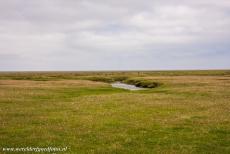
Wadden Sea: About 2300 species of flora and fauna can be found in the vast salt marshes of the Wadden Sea, the sea provides a special and extreme environment for animals and plants and is an important breeding area for birds, such as the common tern, Eurasian spoonbill and Kentish plover. The Wadden Sea is tanking station for migrating birds. It is visited twice a year by twelve million migratory birds. The Wadden Sea is one of the most intriguing nature areas in the world.
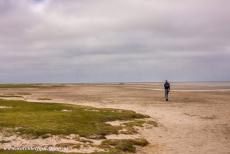
A lonely mudflathiker across the mudflats in the Wadden Sea. The Wadden Sea is extremely treacherous, mudflat hiking without a licenced guide is very dangerous, the sea is continuously changing and creating new mudflats and vast sandbanks. The Wadden Sea stretches from Den Helder in the Netherlands in the southwest to its northern bounderies near the City of Esbjerg in Denmark, crossing the estuaries of the rivers in the northwest of Germany.

Wadden Sea: A tidal area outside the dykes with salt marshes and wadden plains. The Wadden Sea is the largest unbroken system of intertidal sands and mudflats in the world. At low tide, the mudflats and sandflats are exposed and give the birds an easy access to snails, insects, worms and small fish. At high tide, the birds seek shelter behind the dykes. The sands and dunes of the Wadden Sea are popular resting places for seals.
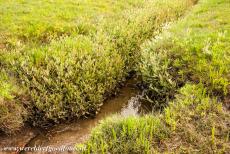
Wadden Sea: The salt marshes are situated between the land and the sea, low salt marshes are covered with water at high tide and exposed at low tide. The salt marshes are overgrown by salt tolerant grasses, herbs and other herbal vegetation. The Wadden Sea provides a special habitat for seals. In the Schleswig-Holstein Wadden Sea in Germany live about 8000 common seals and 200 grey seals, they give birth to their pups on the sandflats of the Wadden Sea.
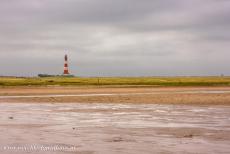
The Wadden Sea comprises the Dutch Wadden Sea Conservation Area and the German Wadden Sea National Park of Lower Saxony and the German Wadden Sea National Park of Schleswig-Holstein and most of the Wadden Sea in Denmark. The Dutch and German parts of the Wadden Sea were inscribed on the UNESCO World Heritage List in 2009, the Danish part of the Wadden Sea was added in 2014.
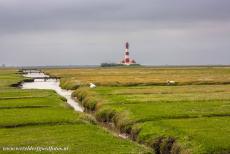
Wadden Sea: The Westerheversand Lighthouse is a major landmark on the Eiderstedt peninsula in Germany. The Westerheversand Lighthouse is surrounded by the sandflats and salt marshes of the Wadden Sea. Thousands of migrating birds pass the lighthouse each year. In spring and autumn, brant and barnacle geese gather on the salt marshes in Schleswig-Holstein for grazing until their journey between the breeding grounds and wintering areas.
